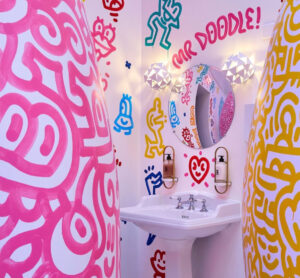There are objects that serve a purpose and those that provoke a pause. Somewhere in between lies the Maison MIHARA YASUHIRO Invisible Key Case—a leather-bound paradox that hides its function so well, it transforms utility into an artistic statement. Released as part of the maison’s ongoing experiment in reimagining the familiar, this key case offers more than craftsmanship or novelty. It delivers a whisper of wit, a gesture of elegance, and a rare kind of design poetry—one that dances with the viewer’s curiosity before revealing its secret.
The Invisible Key Case isn’t invisible in the literal sense. Rather, its invisibility is conceptual—an act of sleight-of-hand embedded within its materials. It looks like a softly distressed mini wallet at first glance, clad in Maison MIHARA’s signature 炙り出し (aburidashi) burn-out leather treatment, giving it a smoky patina as if time has gently toasted its surface. But look closer: embedded beneath the surface lies the faint silhouette of a real key, sealed beneath layers of leather. Not a fake. Not a print. A literal key—locked away and rendered useless, yet absolutely central to the product’s design.
This subversion is precisely the point. By entombing a functional object and replacing its role with aesthetic intrigue, the key case ceases to be just a container—it becomes a meta-object, a meditation on visibility, concealment, and the absurd logic of modern luxury. It’s a joke, but a very refined one. The humor lies in the contradiction, and the elegance lies in its restraint.
Maison MIHARA YASUHIRO has long been a champion of this kind of conceptual fashion. Known widely for its reworked sneakers, exaggerated silhouettes, and playful design cues that tug at the boundary between streetwear and artwear, the brand often treats garments and accessories not as final forms but as living sketches. The Invisible Key Case is no exception. It’s an accessory that tells a story—one of functionality obscured, of industrial objecthood elevated, of craft infused with whimsy.
From a materials standpoint, the craftsmanship is meticulous. The leather surface bears the uneven tonalities of fire-aging, each mark a record of process, not decoration. It’s not polished to perfection but purposely raw—an aesthetic language that MIHARA uses often to suggest that the soul of an object is in its imperfection. The hand-feel is supple yet structured, and the case opens with a quiet snap to reveal a minimal keyring and room for just a few essentials—small, personal items one carries not just out of habit, but out of ritual.
Yet what makes the Invisible Key Case linger in memory is not how it functions, but how it refuses to function traditionally. It gestures toward the absurdity of modern life, where objects are over-designed, where meaning is often hidden behind branding, and where the line between joke and gem becomes fluid. This is where MIHARA thrives—not in loud statements, but in quiet paradoxes.
In the context of gifting, the key case becomes even more poignant. To give someone this object is to offer them not just a useful item, but a moment of recognition. The humor isn’t crass; it’s intimate. It suggests you know the recipient appreciates nuance, detail, and the peculiar pleasure of carrying something that makes others ask, what is that?
The phrase used in the brand’s description—「心を踊らす 粋な計らい」—translates loosely to “a sophisticated gesture that makes the heart dance.” It’s apt. The Invisible Key Case isn’t just a clever design. It’s a subtle choreography of perception and delight. It moves hearts not with extravagance, but with intention. It makes you smile not with logos, but with hidden layers.
Ultimately, the Maison MIHARA YASUHIRO Invisible Key Case operates as a quiet rebellion. In an era where fashion often leans toward spectacle, this small item embodies a different kind of luxury—the luxury of concept, of thoughtfulness, of objects that invite slow looking. It’s not loud, but it echoes. It doesn’t try to explain itself, but it rewards those who take the time to ask questions.
A pocket-sized paradox. A sealed story. A burned-in joke between maker and beholder. In that sense, the Invisible Key Case doesn’t hide meaning—it reveals it, invisibly.
No comments yet.








